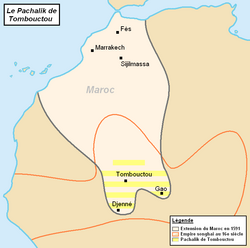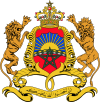
Back باشوية تمبكتو (ولاية) Arabic باشاوية دالسودان ARY Timbuktun paššakunta Finnish Pachalik de Tombouctou French
Pashalik of Timbuktu باشوية تمبكتو (Arabic) | |||||||||
|---|---|---|---|---|---|---|---|---|---|
| 1591–1833 | |||||||||
 Map of the Pashalik of Timbuktu (striped) as part of Morocco, late 16th century. | |||||||||
| Status | Moroccan Governorate (1591–1612) Moroccan Vassal (1612–1826) Tuareg Tributary (1787–1833) | ||||||||
| Capital | Timbuktu | ||||||||
| Religion | Islam | ||||||||
| History | |||||||||
• Established | 1591 | ||||||||
• Disestablished | 1833 | ||||||||
| |||||||||
| Today part of | Mali | ||||||||
| History of Morocco |
|---|
 |
The Pashalik of Timbuktu, also known as the Pashalik of Sudan, was a West African political entity that existed between the 16th and the 19th century. It was formed after the Battle of Tondibi, when a military expedition sent by Saadian sultan Ahmad al-Mansur of Morocco defeated the Songhai Empire and established control over a territory centered on Timbuktu. Following the decline of the Saadi Sultanate in the early 17th century, Morocco retained only nominal control of the Pashalik.[1][2]
- ^ Hunwick, J.O. (2012). "Timbuktu". In Bearman, P.; Bianquis, Th.; Bosworth, C.E.; van Donzel, E.; Heinrichs, W.P. (eds.). Encyclopaedia of Islam, Second Edition. Brill.
- ^ International Scientific Committee for the drafting of a General History of Africa (1999). Ogot, Bethwell Allan (ed.). Africa from the Sixteenth to the Eighteenth Century. Vol. General History of Africa Volume V (Abridged ed.). James Currey. ISBN 0-85255-095-2.
 Text was copied from this source, which is available under a Creative Commons Attribution 3.0 IGO (CC BY 3.0 IGO) license.
Text was copied from this source, which is available under a Creative Commons Attribution 3.0 IGO (CC BY 3.0 IGO) license.